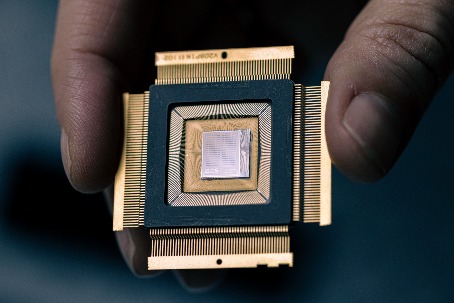Watervlug met een klein brein

Met een brein zo klein als een speldenknopje kunnen insecten toch fantastisch navigeren. Ze ontwijken obstakels en piepen door kleine doorgangen. Hoe doen ze dat, met hun beperkte hersencapaciteit? Als we het insectenbrein begrijpen kan dat ons helpen in de zoektocht naar energiezuinige computers, toont natuurkundige Elisabetta Chicca van de Rijksuniversiteit Groningen met haar meest recente resultaat: een robotje dat zich gedraagt als een insect.
FSE Science Newsroom | Charlotte Vlek

Het is niet niks, om met de beelden die via je ogen binnenkomen te bepalen wat je voeten of vleugels moeten doen. Cruciaal is de ogenschijnlijke beweging van dingen terwijl je zelf beweegt. ‘Zoals wanneer je in de trein zit,’ legt Chicca uit. ‘De bomen langs het spoor lijken snel te bewegen, en de huizen verderop langzaam. Insecten gebruiken deze informatie om hun afstand tot dingen te bepalen. Dat werkt vooral goed als je in een rechte lijn beweegt, maar de realiteit is niet zo eenvoudig.’
Juist bochtige bewegingen zijn voor de kleine hersenen van insecten te complex. Ze maken de wereld behapbaar voor hun beperkte hersencapaciteit door hun gedrag aan te passen: ze vliegen in een rechte lijn, stellen hun koers bij, en vliegen dan weer in een rechte lijn. Chicca legt uit: ‘Wat we hiervan leren is: wanneer je niet genoeg resources hebt, kun je het probleem versimpelen door je gedrag te veranderen.’
Hersens op wielen
Op zoek naar het mechanisme achter het gedrag van een insect ontwikkelde promovendus Thorben Schoepe een model van de neurale activiteit van het beestje, en een klein robotje dat met dit model moest gaan navigeren. Dit alles deed hij onder begeleiding van Chicca, en in een nauwe samenwerking met neurobioloog Martin Egelhaaf van Bielefeld University, die hielp om te ontrafelen welke rekenmethodes het insectenbrein daarvoor gebruikt.
(tekst gaat verder onder de foto)

Aan de basis van Schoepe’s model ligt een enkel principe: stuur altijd naar de plaats met de minste ogenschijnlijke beweging. Hij liet zijn robotje rijden door een lange ‘gang’ (twee opstaande randen met willekeurige print erop), en het robotje bleek netjes in het midden van de gang te blijven, precies zoals insecten dat doen. Ook in andere (virtuele) omgevingen, bijvoorbeeld een ruimte met obstakels of juist met smalle doorgangen, toonde Schoepe’s model soortgelijk gedrag als insecten. ‘Het model is zo goed,’ stelt Chicca, ‘dat je het één keer optuigt, en het daarna in allerlei omgevingen kan functioneren. Dat is het mooie van dit resultaat.’
Vastleggen in plaats van leren
Dat een robotje in een realistische omgeving kan navigeren is niet nieuw. Dit model geeft vooral inzicht in hoe insecten dat doen, en hoe ze dat zo efficiënt doen. Chicca: ‘Robotica houdt zich doorgaans niet bezig met energiezuinigheid. Wij mensen leren nieuwe dingen als we opgroeien, en in robotica zie je dit terug in de huidige trend van machine learning. Maar insecten kunnen meteen vanaf hun geboorte vliegen. De efficiënte manier om dat te doen is als het ware ingebouwd in hun brein.’

Op eenzelfde manier kun je ook computers energiezuinig maken. Chicca laat een chip zien die haar onderzoeksgroep eerder al produceerde: een plaatje met een oppervlak zo klein als een toets op je toetsenbord. In de toekomst hoopt ze ook dit insectengedrag in zo’n chip te kunnen vastleggen. Ze licht toe: ‘In plaats van een general purpose-computer met alle mogelijkheden die dat biedt, kun je ook specifieke hardware bouwen, een kleine chip, die het werk kan doen. Dan houd je het veel kleiner en energiezuiniger.’
Details:
Elisabetta Chicca is deel van het Groningen Cognitive Systems and Materials Center (CogniGron). De missie van CogniGron is om zelf-lerende materialen en systemen te ontwikkelen, geïnspireerd op het menselijk brein, en daarmee een blauwdruk voor toekomstbestendige computers.
